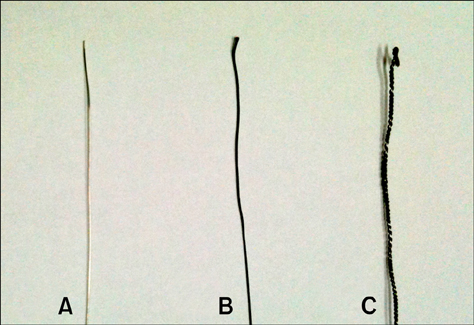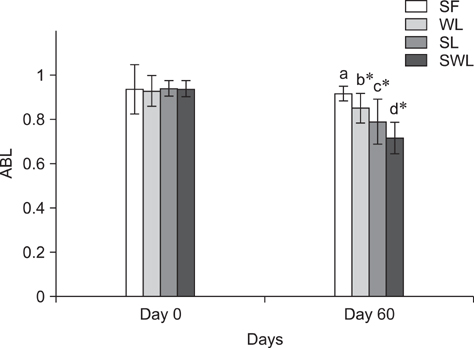J Vet Sci.
2012 Jun;13(2):193-197. 10.4142/jvs.2012.13.2.193.
A modified method for inducing periodontitis in dogs using a silk-wire twisted ligature
- Affiliations
-
- 1Department of Veterinary Surgery, College of Veterinary Medicine, Seoul National University, Seoul 151-742, Korea. kmseo@snu.ac.kr
- KMID: 1376194
- DOI: http://doi.org/10.4142/jvs.2012.13.2.193
Abstract
- This study was designed to assess the effectiveness of a modified silk ligature twisted with wire for inducing advanced periodontitis. Periodontitis was induced in five premolars and one molar of 20 healthy dogs over a 60-day period. The dogs were divided into four groups according to the ligature-inducing materials used: soft moistened food only, wire ligature (WL), silk ligature (SL) and twisted ligature with silk and wire (SWL). Periodontal indices were recorded, and dental radiographs were taken before and after 60 days of ligation. The ligatures were checked daily and the day the ligature fell out was noted. The period during which the ligatures were maintained was significantly shorter for the SL group compared to the SWL group (p < 0.05). Results of the clinical examination showed that almost all periodontal status parameters including the plaque index, gingival index, clinical attachment level, and bleeding on probing were significantly exacerbated in the SWL group compared to the other groups (p < 0.05). Radiographic evaluation demonstrated that alveolar bone levels were significantly lower in the SWL group than the other groups on day 60 (p < 0.05). These results suggested that experimental periodontitis induced by SWL could be an effective method for investigating periodontitis in canine models.
Keyword
MeSH Terms
Figure
Reference
-
1. Bellows J. Small Animal Dental Equipment, Materials and Techniques: a Primer. 2004. 1st ed. Ames: Willey-Blackwell;115–173.2. Castelli WA, Nasjleti CE, Caffesse RE, Diaz-Perez R. Gingival response to silk, cotton, and nylon suture materials. Oral Surg Oral Med Oral Pathol. 1978. 45:179–185.
Article3. de Oliveira RR, Novaes AB Jr, Garlet GP, de Souza RF, Taba M Jr, Sato S, de Souza SLS, Palioto DB, Grisi MF, Feres M. The effect of a single episode of antimicrobial photodynamic therapy in the treatment of experimental periodontitis. Microbiological profile and cytokine pattern in the dog mandible. Lasers Med Sci. 2011. 26:359–367.
Article4. Ericsson I, Lindhe J, Liljenberg B, Persson AL. Lack of bacterial invasion in experimental periodontitis. J Clin Periodontol. 1987. 14:478–485.
Article5. Ericsson I, Lindhe J, Rylander H, Okamoto H. Experimental periodontal breakdown in the dog. Scand J Dent Res. 1975. 83:189–192.
Article6. Fossum TW. Fossum TW, Hedlund CS, Hulse DA, Johnson AL, Seim HB, Willard MD, Carroll GR, editors. Biomaterials, suturing, and hemostasis. Small Animal Surgery. 2002. 2nd ed. St. Louis: Mosby;43–59.7. Haze A, Taylor AL, Haegewald S, Leiser Y, Shay B, Rosenfeld E, Gruenbaum-Cohen Y, Dafni L, Zimmermann B, Heikinheimo K, Gibson CW, Fisher LW, Young MF, Blumenfeld A, Bernimoulin JP, Deutsch D. Regeneration of bone and periodontal ligament induced by recombinant amelogenin after periodontitis. J Cell Mol Med. 2009. 13:1110–1124.
Article8. Kirkwood KL, Cirelli JA, Rogers JE, Giannobile WV. Novel host response therapeutic approaches to treat periodontal diseases. Periodontol 2000. 2007. 43:294–315.
Article9. Lindhe J, Hamp S, Löe H. Experimental periodontitis in the beagle dog. J Periodontal Res. 1973. 8:1–10.
Article10. Löe H, Silness J. Periodontal disease in pregnancy. I. Prevalence and severity. Acta Odontol Scand. 1963. 21:533–551.
Article11. Martuscelli G, Fiorellini JP, Crohin CC, Howell TH. The effect of interleukin-11 on the progression of ligature-induced periodontal disease in the beagle dog. J Periodontol. 2000. 71:573–578.
Article12. Okada Y, Hamada N, Kim Y, Takahashi Y, Sasaguri K, Ozono S, Sato S. Blockade of sympathetic β-receptors inhibits Porphyromonas gingivalis-induced alveolar bone loss in an experimental rat periodontitis model. Arch Oral Biol. 2010. 55:502–508.
Article13. Ramamurthy NS, Xu JW, Bird J, Baxter A, Bhogal R, Wills R, Watson B, Owen D, Wolff M, Greenwald RA. Inhibition of alveolar bone loss by matrix metalloproteinase inhibitors in experimental periodontal disease. J Periodontal Res. 2002. 37:1–7.
Article14. Salvi GE, Lang NP. Host response modulation in the management of periodontal diseases. J Clin Periodontol. 2005. 32:Suppl 6. 108–129.
Article15. Schroeder HE, Lindhe J. Conversion of stable established gingivitis in the dog into destructive periodontitis. Arch Oral Biol. 1975. 20:775–782.
Article16. Silness J, Löe H. Periodontal disease in pregnancy. II. Correlation between oral hygiene and periodontal condition. Acta Odontol Scand. 1964. 22:121–135.
Article17. Tillmanns HWS, Hermann JS, Tiffee JC, Burgess AV, Meffert RM. Evaluation of three different dental implants in ligature-induced peri-implantitis in the beagle dog. Part II. Histology and microbiology. Int J Oral Maxillofac Implants. 1998. 13:59–68.18. Tubb M, Williams FE, Frazier LW. Gingival crevicular fluid prostaglandins and gingival phospholipids in experimentally-induced periodontitis in the dog. Arch Oral Biol. 1990. 35:529–533.
Article19. Wennström JL, Newman HN, MacNeill SR, Killoy WJ, Griffiths GS, Gillam DG, Krok L, Needleman IG, Weiss G, Garrett S. Utilisation of locally delivered doxycycline in non-surgical treatment of chronic periodontitis. A comparative multi-centre trial of 2 treatment approaches. J Clin Periodontol. 2001. 28:753–761.
Article20. Xie R, Kuijpers-Jagtman AM, Maltha JC. Inflammatory responses in two commonly used rat models for experimental tooth movement: comparison with ligature-induced periodontitis. Arch Oral Biol. 2011. 56:159–167.
Article21. Zitzmann NU, Berglundh T, Ericsson I, Lindhe J. Spontaneous progression of experimentally induced periimplantitis. J Clin Periodontol. 2004. 31:845–849.
Article
- Full Text Links
- Actions
-
Cited
- CITED
-
- Close
- Share
- Similar articles
-
- Development of animal experimental periodontitis models
- Comparison of the frictional resistance between orthodontic bracket & archwire
- Temporal changes of periodontal tissue pathology in a periodontitis animal model
- Mongolian Gerbil as a Novel Animal Model for Ligature-induced Periodontitis
- Frictional forces between orthodontic wire and bracket under artificial saliva



